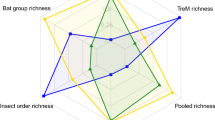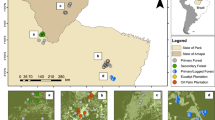Abstract
Despite concern about the effects of tropical forest disturbance and clearance on biodiversity1,2, data on impacts, particularly on invertebrates, remain scarce3,4,5,6,7,8. Here we report a taxonomically diverse inventory on the impacts of tropical forest modification at one locality. We examined a gradient from near-primary, through old-growth secondary and plantation forests to complete clearance, for eight animal groups (birds, butterflies, flying beetles, canopy beetles, canopy ants, leaf-litter ants, termites and soil nematodes) in the Mbalmayo Forest Reserve, south-central Cameroon. Although species richness generally declined with increasing disturbance, no one group serves as a good indicator taxon9,10,11,12 for changes in the species richness of other groups. Species replacement from site to site (turnover) along the gradient also differs between taxonomic groups. The proportion of ‘morphospecies’ that cannot be assigned to named species and the number of ‘scientist-hours’ required to process samples both increase dramatically for smaller-bodied taxa. Data from these eight groups indicate the huge scale of the biological effort required to provide inventories of tropical diversity, and to measure the impacts of tropical forest modification and clearance.
This is a preview of subscription content, access via your institution
Access options

Similar content being viewed by others
References
Whitmore, T. C. & Sayer, J. A. (eds) Tropical Deforestation and Species Extinction (Chapman and Hall, London, (1992)).
Marshall, A. G. & Swaine, M. D. Tropical rain forest: disturbance and recovery. Phil. Trans. R. Soc. Lond. B 335, 323–457 ( 1992).
Sutton, S. L. & Collins, N. M. in Conservation of Insects and their Habitats (eds Collins, N. M. & Thomas, J. A.) 405– 424 (Academic, London, (1991)).
Collins, N. M. The effect of logging on termite diversity and decomposition processes in lowland dipterocarp forests. Trop. Ecol. Dev. 198, 113–121 (1980).
Wood, T. G. et al. Abundance and distribution of termites (Isoptera) in a riparian forest in the southern Guinea savanna vegetation zone of Nigeria. Biotropica 14, 25–39 ( 1982).
Bowman, D. J. M. S. et al. Slash-and-burn agriculture in the wet coastal lowlands of Papua New Guinea: responses of birds, butterflies and reptiles. J. Biogeog. 17, 227–239 (1990).
Hill, J. K. et al. Effects of selective logging on tropical forest butterflies on Buru, Indonesia. J. Appl. Ecol. 32, 754 –760 (1995).
Watt, A. D. et al. in Forests and Insects (eds Watt, A. D, Stork, N. E. & Hunter, M. D.) 271–284 (Chapman and Hall, London, (1997)).
Davidar, P. et al. in Measuring and Monitoring Biodiversity in Tropical and Temperate Forests (eds Boyle, T. J. B. & Boontawee, B.) 287– 301 (Centre for International Forestry Research, Bogor, Indonesia, (1995)).
Gaston, K. J. (ed.) Biodiversity. A Biology of Numbers and Difference (Blackwell, Oxford, (1996)).
Oliver, I. O. & Beattie, A. J. Designing a cost-effective invertebrate survey: a test of methods for rapid assessment of biodiversity. Ecol. Appl. 6, 594–607 ( 1996).
Prendergast, J. R. & Eversham, B. C. Species richness covariance in higher taxa: empirical tests of the biodiversity indicator concept. Ecography 20, 210–216 (1997).
Louette, M. & Bijnens, L. The utility of birds as bioindicators—case-studies in equatorial Africa. Belg. J. Zool. 125, 157–165 (1995).
Bloemers, G. F. et al. The effects of forest disturbance on diversity of tropical soil nematodes. Oecologia 111, 575– 582 (1997).
Eggleton, P. et al. The diversity, abundance and biomass of termites under differing levels of disturbance in the Mbalmayo Forest Reserve, southern Cameroon. Phil. Trans. R. Soc. Lond. B 351, 51– 68 (1996).
Watt, A. D. et al. Impact of forest management on insect abundance and damage in a lowland tropical forest in southern Cameroon. J. Appl. Ecol. 34, 985–998 ( 1997).
Estrada, A., Coates-Estrada, R. & Merritt, D. J Non flying mammals and landscape changes in the tropical rain forest region of Lost Tustlas, Mexico. Ecography 17, 229–241 (1994).
Canaday, C. Loss of insectivorous birds along a gradient of human impact in Amazonia. Biol. Conserv. 77, 63– 77 (1996).
Prendergast, J. R. et al. Rare species, the coincidence of diversity hotspots and conservation strategies. Nature 365, 335– 337 (1993).
Dobson, A. P. et al. Geographic distribution of endangered species in the United States. Science 275, 550– 553 (1997).
Johns, A. G. Bird population persistence in Sabahan logging concessions. Biol. Conserv. 75, 3–10 ( 1996).
Harrison, S., Ross, S. J. & Lawton, J. H. Beta diversity on geographic gradients in Britain. J. Anim. Ecol. 61, 151– 158 (1992).
Cornell, H. V. & Lawton, J. H. Species interactions, local and regional processes, and limits to the richness of ecological communities: a theoretical perspective. J. Anim. Ecol. 61, 1–12 (1992).
Eggleton, P. & Bignell, D. E. in Insects in a Changing Environment (eds Harrington, R. & Stork, N. E.) 473– 497 (Academic, London, (1995)).
May, R. M. How many species are there on earth? Science 241, 1441–1449 (1988).
Blackmore, S. Knowing the Earth's biodiversity: challenges for the infrastructure of systematic biology. Science 274, 63– 64 (1996).
Blockhus, J. M. et al. (eds) Conserving Biological Diversity in Managed Tropical Forests. Proc. Workshop, IUCN General Assembly, Perth, Australia 1990 (Gland, IUCN/ITTO, Cambridge, (1992)).
Johns, A. G. & Johns, B. G. Tropical forests and primates: long term co-existence. Oryx 29, 205– 211 (1995).
Mackworth-Praed, C. W. & Grant, C. H. B. Birds of West Central and Western Africa. African Handbook of Birds Series 3, Vols I and II(Longman, London, (1981)).
Hammond, P. M. in Insects and the Rain Forests of South East Asia (Wallacea) (eds Knight, W. J. & Holloway, J. D.) 197–254 (Royal Entomological Society, London, (1990)).
Acknowledgements
We thank T. Blackburn, R. Booth, M. Brendell, T. Brown, J. Davies, R. Didham, D.Nguele, J. Fanguem, G. Lawson, R. Leakey, E. Lindsay, J. Mason, M. Mboglen, C. Mcbeath, P. Ngeh, A.Roby, R. Sands, Z. Tchoundjeu, J. Tchoupa, J. Tipa, F. Wanless, B. Waite, M. West, T. Wood and E.Wright for technical and taxonomic help and discussion. J.H.L. is an honorary research associate at the NHM. We thank the Government of Cameroon (Office National de Dévéloppement des Forêts), the International Institute of Tropical Agriculture, the UK Overseas Development Administration, and the UK Natural Environment Research Council TIGER Programme for logistical and financial support.
Author information
Authors and Affiliations
Corresponding author
Rights and permissions
About this article
Cite this article
Lawton, J., Bignell, D., Bolton, B. et al. Biodiversity inventories, indicator taxa and effects of habitat modification in tropical forest. Nature 391, 72–76 (1998). https://doi.org/10.1038/34166
Received:
Accepted:
Published:
Issue Date:
DOI: https://doi.org/10.1038/34166
This article is cited by
-
Effectiveness of higher-taxon approach on ants and sample size effect: an assessment in Brazilian biomes and states
Biodiversity and Conservation (2023)
-
Allochthonous material originating from saprolite as a marker of termite activity in Ferralsols
Scientific Reports (2022)
-
Diversity and spatial distribution of butterflies in different macrohabitat of North East India
International Journal of Tropical Insect Science (2022)
-
A Preliminary Study of Butterfly Diversity in Hilly Terrains of Ghatsila, Jharkhand, India
Proceedings of the Zoological Society (2022)
-
A decision support tool for integrated fisheries bycatch management
Reviews in Fish Biology and Fisheries (2022)
Comments
By submitting a comment you agree to abide by our Terms and Community Guidelines. If you find something abusive or that does not comply with our terms or guidelines please flag it as inappropriate.



